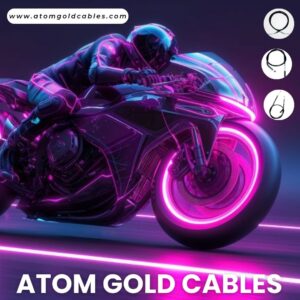Motorcycle brake cables are essential for rider safety, allowing precise control of braking power when needed. However, these cables endure significant stress, with heat and friction being two of the primary forces they encounter. Over time, heat and friction can wear down brake cables, reducing their efficiency and even leading to dangerous failures. This article explores the impacts of heat and friction on motorcycle brake cables and offers tips on how to mitigate these effects for a safer ride.

Understanding the Role of Brake Cables
Brake cables in motorcycles are responsible for transferring the force from the rider’s hand or foot to the braking mechanism, allowing the motorcycle to slow down or stop. These cables work under constant tension and are exposed to various elements, including heat, friction, and environmental conditions. Quality brake cables are designed to withstand these forces, but consistent exposure can still degrade their performance over time.
How Heat Affects Brake Cables
When brakes are applied, the energy generated by the stopping process is converted into heat. The more frequently and forcefully the brakes are used, the more heat they produce. This heat can impact the brake cables in several ways:
1. Material Degradation
Brake cables are often made from materials like stainless steel and lined with heat-resistant coatings. However, repeated exposure to high temperatures can cause even the best materials to degrade over time. For instance, excessive heat may weaken the metal strands within the cable, making them more susceptible to breakage.
2. Increased Cable Stretch
High temperatures can cause brake cables to expand slightly, leading to an effect called “cable stretch.” When cables stretch, they may lose tension, resulting in a “spongy” feeling when braking. This can compromise the rider’s control and increase stopping distances, reducing braking efficiency.
3. Deterioration of Cable Housing
The cable housing, which surrounds the brake cable, is often made of materials like plastic or rubber. High heat can cause this housing to become brittle or even melt, compromising the cable’s overall integrity. Without effective housing, the cable may not operate smoothly, leading to potential safety issues.
The Role of Friction in Brake Cable Wear
Friction is another significant force acting on brake cables. When the brake lever is pulled, the cable moves within its housing, creating friction between the cable and its protective sheath. Over time, this friction can wear down the cable’s surface, reducing its efficiency and lifespan.
1. Cable Surface Wear
The constant friction between the cable and its housing can cause the outer surface of the cable to wear down. This can lead to thinning, fraying, or even snapping if the cable isn’t regularly maintained. A worn cable surface may also lead to inconsistent braking, which can be dangerous for riders.
2. Increased Resistance
As friction wears down the cable, it can create more resistance within the housing. This added resistance can make braking feel less responsive, requiring the rider to apply more force to achieve the same braking effect. Increased resistance may also increase cable stretch, further reducing braking efficiency.
3. Heat Generated by Friction
Friction itself generates heat, especially during prolonged or intense braking. This heat can amplify the effects of external heat, accelerating the degradation of both the cable and housing. Combined with high temperatures from frequent braking, this internal friction-generated heat can have a cumulative effect, wearing out brake cables even faster.
Signs That Heat and Friction Are Affecting Your Brake Cables
Regular inspection of motorcycle brake cables can help riders identify signs of wear and tear caused by heat and friction. Here are some indicators that your cables may be affected:
1. Visible Wear or Fraying
Inspect the outer surface of the brake cable for any visible wear, fraying, or rust. If you notice any signs of wear, it’s time to replace the cable before it becomes a safety hazard.
2. Reduced Braking Responsiveness
If your brakes feel less responsive or require more force to engage, it could be a sign of cable stretch or increased resistance within the housing. These symptoms may indicate that the cable has been affected by heat and friction.
3. Brittle or Damaged Housing
Inspect the cable housing for any signs of brittleness, cracking, or melting. Damaged housing can restrict the smooth movement of the cable, making braking less effective and increasing the risk of cable failure.
Preventative Measures to Protect Brake Cables from Effects of heat and friction on motorcycle brake cables
To ensure your brake cables remain in good condition, there are several steps you can take to minimize the effects of heat and friction:
1. Choose High-Quality Cables
Investing in high-quality, heat-resistant brake cables can significantly reduce the impact of heat and friction. Stainless steel cables with durable, heat-resistant coatings tend to perform better over time, providing better resistance to these forces.
2. Use Lubricants
Applying a high-temperature lubricant to the brake cable can reduce friction within the housing, allowing smoother operation and less wear. However, make sure to use a lubricant recommended for motorcycle brake cables, as some products may attract dirt or degrade the housing material.
3. Avoid Over-Braking
Excessive braking generates more heat, which can accelerate cable wear. Practice smooth, controlled braking to minimize heat buildup, and avoid riding with the brakes engaged for prolonged periods. If you’re riding downhill or in traffic, use engine braking when possible to reduce the strain on your brake cables.
4. Regularly Inspect and Replace Cables
Regular inspections can help identify issues before they become major problems. Check your brake cables and housing for any signs of wear, and replace them as needed. Many experts recommend replacing brake cables periodically, even if there are no visible signs of damage, to maintain optimal performance.
The Cost of Ignoring Cable Maintenance
Neglecting the effects of heat and friction on brake cables can lead to costly repairs and potential safety risks. Worn brake cables are more likely to snap or fail unexpectedly, putting both the rider and the motorcycle at risk. In the worst-case scenario, brake failure due to cable degradation could result in accidents.
Financial Costs
If brake cables are not maintained and fail prematurely, they may cause additional wear on other braking components, leading to costly repairs. Replacing brake cables regularly and using quality components can help avoid these expenses.
Safety Risks
The most significant consequence of ignoring brake cable maintenance is the increased risk of accidents. Degraded cables can compromise braking performance, potentially leading to dangerous situations. Regular maintenance is essential for ensuring safe, reliable braking.
Conclusion
Heat and friction are two unavoidable forces that motorcycle brake cables face, but understanding their effects and taking preventative measures can greatly extend cable life and ensure safety. By choosing high-quality cables, applying lubricants, and practicing smooth braking, riders can minimize the impact of heat and friction on their brake cables. Regular inspection and replacement are also key steps to maintaining reliable braking performance. Proper maintenance not only saves on repair costs but also contributes to a safer and more enjoyable riding experience.
Find the Atom Gold difference today – where the heritage of the past is merged with the technology of the future, and quality is the standard.
For more information about our products or to place an order, visit our website or contact us at our office in Ghaziabad, UP. Let us help you drive with confidence, powered by the best accelerator cables in the industry.
Visit us at -Shree Radha Nath Automotive Pvt Ltd , Plot No-35, NCR Industrial Park GT Road Sahibabad, Near Raj Bagh Metro Station, Ghaziabad, UP -201005. Mobile- 9873097340, 82870 63431 Ghaziabad, Uttar Pradesh, India 201005
Follow us on Social Media –
